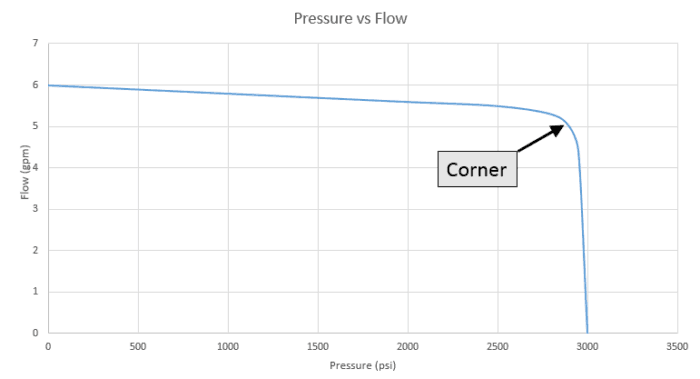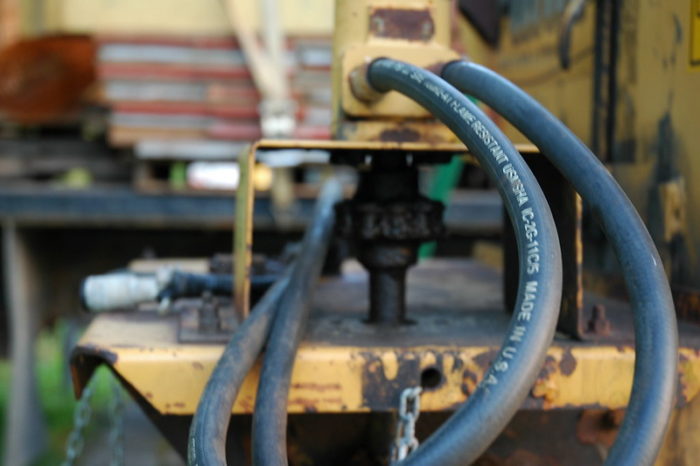Over the past 20 years, most of the hydraulic systems I’ve worked on have been between 2500 psi and 3000 psi (165 to 207 bar). There have been a few subsystems where the pressure was less (600 psi, 41 bar) and once where the pressure was intensified to 10,000 psi (690 bar)!
The question I’ve never really asked is, “What is the ideal system pressure for hydraulics?”

The ideal hydraulic system pressure range is between 2500 and 3000 psi (172 to 207 bar) because of safety, internal leakage, weight and size. Also, many components are not available in higher pressures. Higher pressure hydraulics makes the most sense when using hydraulic motors or space constraints are an issue.
Safety
Hydraulics are inherently dangerous. Pin hole leaks can shoot out fluid strong enough to cut off your arm! If it gets in your blood stream, hydraulic oil can stop your heart.
Common sense tells us that if we have these issues at lower pressures, amplifying the pressure only make the problem or the likelyhood of the problem worse. A 10,000 psi system is more prone to leakage and hose wear than a 3,000 psi system. These lead to safety issues.
I would postulate that as you double the pressure, you are 4x to 8x more likely to have issues with leakage and wear.
Internal Leakage
Hydraulic components aren’t leak proof. In a gear pump, there are small cavities between the gear lands and the shell. There are also small gaps between the cavity and the side of the gear. The graph below shows how flow is reduced from 6 gpm to 5.5 gpm as the pressure increases from 0 to 2800 psi.

Pumps are not the only components that leak, valves are also notorious. A typical valve spool must be smaller than the bore it fits in. With modern machining capabilities, these bores can be honed with a gap that is roughly 0.0005″ (1.27 μm). That is a very tight tolerance, but it is large enough to leak. This is why we don’t use valves to hold loads for long periods of time.
Cylinders also leak. The seals can only seal so well, which means leakage. This is compounded as the cylinder ages and pitting and other dents form on the rod.
To mitigate some of these risks, there may be several seals on the piston and end gland. If one seal fails, others will be there as a backup.
However, in normal use, a seal may leak some pressure across one seal to the next. Imagine a cylinder where there were two seals on a piston and you were extending the cylinder with full pressure of 3000 psi. If both seals leaked a little bit, eventually the pressures would be 3000 psi in the barrel, 0 psi in the rod and 1500 psi in between the seals. In this case, we will have some leakage, but it has a smaller pressure range over each seal (1500 psi and not 3000 psi)
All this is to illustrate that components leak. Amplifying the pressure is a sure way to make them leak faster.
Weight Issues
Every cylinder application is somewhat unique. Some cylinders are only in compression, others only in tension and some switch from compression to tension as the stroke increases. On top of that, there are so many pressures we can operate at.
As we select a cylinder, we need to consider the extend and retract forces, buckling and weight. Buckling here is the unseen culprit and can lead to very heavy cylinders.
Let’s look at the example of a 30″ stroke cylinder that needs to support 38 kip in compression at full length. We will use the Euler buckling strength to determine the rod size.
| Bore | 2000 | 2500 | 3000 | |||||||||
|---|---|---|---|---|---|---|---|---|---|---|---|---|
| Force | OD | Rod | Weight/in | Force | OD | Rod | Weight/in | Force | OD | Rod | Weight/in | |
| in | kip | in | in | lb/in | kip | in | in | lb/in | kip | in | in | lb/in |
| 3 | 16.6 | 3.25 | 2 | 1.2 | 21.6 | 3.375 | 2 | 1.4 | 27 | 3.38 | 2.25 | 1.7 |
| 4 | 29.5 | 4.38 | 2.25 | 1.8 | 38.4 | 4.5 | 2.5 | 2.3 | 47.9 | 4.5 | 2.5 | 2.3 |
| 5 | 46.1 | 5.5 | 2.5 | 2.6 | 60 | 5.63 | 2.75 | 3.2 | 74.9 | 5.75 | 2.75 | 3.5 |
| 6 | 66.4 | 6.5 | 2.75 | 3.1 | 86.4 | 6.63 | 3 | 3.8 | 107.9 | 6.88 | 3 | 4.5 |
| 8 | 118 | 8.75 | 3 | 4.8 | 153.5 | 9 | 3.25 | 6.1 | 191.8 | 9.25 | 3.5 | 7.5 |
| Bore | 4000 | 5000 | ||||||||||
| Force | OD | Rod | Weight/in | Force | OD | Rod | Weight/in | |||||
| in | kip | in | in | lb/in | kip | in | in | lb/in | ||||
| 3 | 39 | 3.63 | 2.38 | 2.2 | 52.8 | 3.75 | 2.5 | 2.5 | ||||
| 4 | 69.3 | 4.75 | 2.75 | 3.1 | 93.9 | 5 | 3 | 4.0 | ||||
| 5 | 108.2 | 5.88 | 3 | 4.1 | 146.7 | 6.25 | 3.25 | 5.5 | ||||
| 6 | 155.9 | 7.25 | 3.25 | 6.0 | 211.2 | 7.5 | 3.5 | 7.2 | ||||
| 8 | 277.1 | 9.5 | 3.75 | 9.0 | 375.4 | 10 | 4.25 | 12.0 | ||||
From the table above, we need:
- 3″ bore @ 5000 psi
- 3″ bore @ 4000 psi
- 4″ bore @ 3000 psi
- 4″ bore @ 2500 psi
- 5″ bore @ 2000 psi
Working at 3000 and 5000 psi, the cylinder is over designed and there is not added benefit. I makes sense to reduce the pressures to 2500 and 4000 psi respectively. The 3″ bore cylinder working at 4000 psi is the lightest cylinder for the job.
You may be asking, why wouldn’t I reduce the bore of the 5000 psi cylinder to make it lighter. (Very good question BTW) The answer is buckling. The rod size needs to be 2.5″ on a 3″ bore cylinder. There isn’t much room to decrease the bore. Buckling is a common problem with high pressure cylinders that usually leads to increased weight. One way to mitigate this is to use a hollow rod which keeps the needed buckling strength (high “I”) while reducing cross sectional area.

Hose Limitations
Going to high pressure creates other problems. As you increase the pressure, you increase the stiffness of the hose. This makes hose routing more complicated when moving parts are involved
If you are using a hose carrier, note that the bend radius will need to increase. This means trouble if you are planning to run the hose carrier inside of a structure.
Availability of Components
If going to high pressure is necessary, you will notice that there are far fewer choices of components. Pumps, valves, fittings and hoses will be in short supply. The usually unseen cost of fittings will go up dramatically due to stronger materials with more mass.
Another thing that makes me gag is that many of the fittings are only available in pipe thread (NPT). The use of teflon and proper tightening, especially on 90° fittings, is frustrating. If you make a mistake with the fitting orientation, you need to start all over. I tend to avoid NPT fittings at all costs.
Where It Makes Sense to Go to Higher Pressures
I’ve spent the majority of this article trying to keep your system pressure under 3000 psi. Now we need to focus on when should we go to higher pressures.
There really two main reasons to go to high pressure: to reduce flow to components and better use of accumulators.
Reducing Flow to Components
Power is force x velocity. In a cylinder, we can keep the force constant by increasing the pressure and reducing the bore. As a result, we need less flow to maintain the same velocity. The benefit here is we can use smaller hoses for the same amount of work.
However, cylinders aren’t the primary benefactors; hydraulic motors are! Running a motor at higher pressures (4500 psi) can significantly reduce the flow and hose size. Above is the drive system for Top Thrill Dragster at Cedar Point. The hydraulic motors turn the large cable drum. The cable system launches the coaster from 0 to 120 mph in 3.8 seconds.
Better Use of Accumulators
In the picture of Top Thrill Dragster above, you’ll notice the red tanks. Those are large piston accumulators and they make the launch possible by storing high pressure fluid between launches.
Accumulators are complicated to design, but one guiding principle is that they work better at high pressures. If the launch system only operated at 3000 psi (or less), you would need much larger accumulators to achieve this launch.
Conclusion
You will find that keeping the system pressure under 3000 psi (207 bar) will give you access to a wide variety of hoses, fittings, adapters and components. Pressures between 2400 psi (172 bar) and 3000 psi will give you the lightest cylinders. In some cases, you can find these cylinders stocked in local stores or online.

